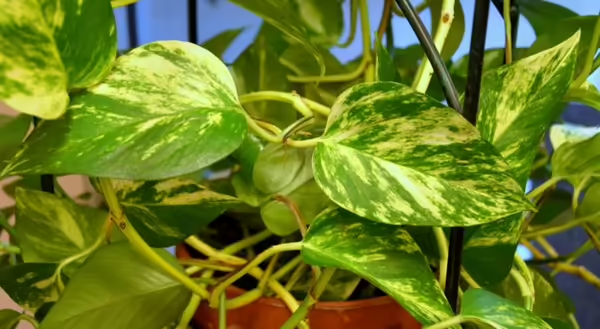
Two houseplants that are often confused with each other are philodendron and pothos. Many houseplants are referred to as philodendron, but most are probably actually pothos. Both are vining plants with green leaves, but they have some distinctive characteristics that will help you to tell them apart.
Philodendrons
Philodendrons are popular because they tolerate very low light and variable temperatures.
Philodendrons are a group of tropical plants with variously shaped and colored leaves. There are two common types of philodendron houseplants, vining and self-heading.
The self-heading types grow from a clump at the base and can have large leaves in a variety of shapes. Most people grow the heartleaf philodendron (Philodendron scandens subsp. oxycardium).
Heartleaf philodendron is a rapidly growing vine plant. It has familiar heart-shaped, smooth, dark green leaves on slender, flexible vines. This plant grows rapidly.
Pothos
Pothos need a bit more light and warmer temperatures than philodendrons.
Pothos are quite different plants. The pothos (also called Devil's Ivy) is also a tropical vine. The difference is that it has crisp, shiny leaves with gold, white, or yellow markings. The most common pothos is the silver pothos (Epipremnum aureum 'Marble Queen'). It has slightly raised/bumpy texture, waxy leaves variegated with white, especially when young. Pothos need higher light levels in order to develop good leaf markings and variegation.
New leaves on a philodendron are wrapped in a waxy, thin, opaque sheath called a cataphyll. This cataphyll will turn brown and fall away once the leaf has emerged. The new leaves of a philodendron have a pinkish or brownish color. New pothos leaves extend from the current leaf. They unfurl a lighter green color than the older leaves.
Tropical Environment Preferred
Both plants do something extraordinary when grown in their preferred tropical environment. They can produce both juvenile and adult leaves. Typically, we only see the juvenile leaves in our home environments. Adult leaves are larger and sometime shaped differently than the juvenile leaves. You'll see the larger adult leaves at the top of the vining plant once it reaches a certain height. Because flowers only form when the plant is in the mature stage, we don’t usually see flowers forming on our houseplants.
Stem Characteristics
You can also use some stem characteristics to determine the difference. The petioles on a pothos have a groove, but the philodendrons do not. Both vines have aerial roots. Pothos have one small root at a node while philodendrons have multiple roots at a node.
Air Purifier
These plants are listed as two of the top best plants to clean indoor air. Research done by NASA in the late 1980's found that several houseplants remove common indoor pollutants such as those found in carpets, furniture, building materials, and cleaning products. The study recommends having at least 15 air cleaning houseplants for the average 2,000 square foot home.
Do you have pothos and philodendron growing in your house? If not, find a friend who does and have them propagate one for you.
MEET THE AUTHOR
Nicole Flowers-Kimmerle is a Agriculture and Natural Resources (Horticulture) Educator for Fulton, Mason, Peoria and Tazewell counties. She completed a bachelors of science degree in crop science at the University of Illinois, and a master’s of science degree in agronomy with an emphasis in weed science at the University of Wisconsin-Madison. She has also worked at Montana State University as a research associate where she worked on weed control in sugar beets and barley. She taught high school chemistry and other science classes where she was able to teach students in both the school garden and greenhouse. She works with both the Extension Master Gardeners and Extension Master Naturalists.
ABOUT THE BLOG
ILRiverHort is a blog that helps people connect to nature and grow.